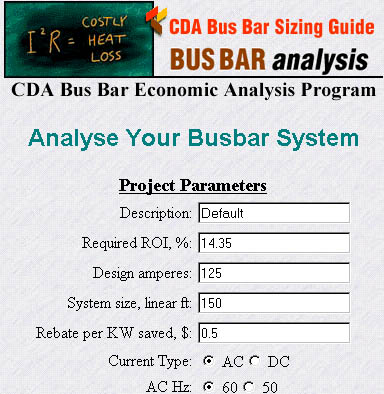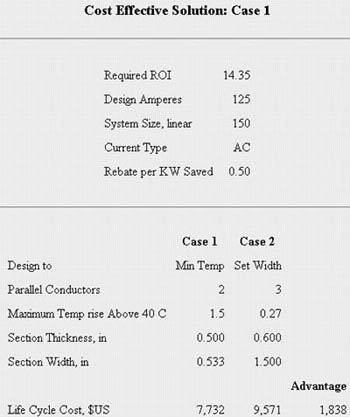Copper Busbar Sizing Guide
Copper Applications in Electrical Area
CDA Energy Efficiency Promotion
For several years the Copper Development Association has promoted the use of energy-efficient electrical equipment and systems. The program helps users determine when the electrical cost savings from using efficient systems offsets the increased first cost of the more efficient systems. In other words, the program emphasizes systems with the lowest life-cycle cost. 
CDA's energy efficiency program currently examines motors, transformers, and wire and busbar systems. Life-cycle cost analysis has also been done in some other areas such as magnetic ballasts for fluorescent lights.
The program can be reviewed in Energy Section. The most recent addition to CDA's program is the Busbar Sizing Guide (Busbar Section).
Busbar Sizing Guide
The Copper Busbar Sizing Guide is an outgrowth of a similar PC program. It helps users find the busbar system with the lowest life-cycle cost. This is done by comparing the cost of installing and operating (electricity costs only) systems with different size conductors.
In addition to the sizing analysis program the site also includes:
- US Sources of Busbar
- Ampacities of Copper Busbar
- Typical Busbar Sizes
Why did CDA develop the busbar sizing guide?
- First, to overcome a first-cost bias in the installation of wire and busbar systems. Contracts are often awarded to the firm offering the lowest bid, rather than for systems with the lowest life-cycle cost.
- Second, conductors are often sized as small as possible, subject to the constraint that they meet relevant safety codes or industry standards. These codes and standards usually take no account of the economics of using the systems, only of insuring their safe operation.
If a busbar system generates sufficient heat to be anywhere near the range where it could become a safety threat it must be wasting an enormous amount of energy. Systems built at or near code minimums are potentially in this range.
CDA has found that there are many applications in which undersized conductors are used. This results in the uneconomic use of electricity. This is the case even when energy savings are discounted at high interest rates.
Who needs the Busbar Sizing Guide
Several audiences are likely to find the Busbar Sizing Guide useful. The first, of course, is large users of electricity. They directly benefit from economically sized systems. Electrical contractors and engineers will also find the site useful in the design of the systems. Utilities, a third target audience can use the guide as a tool and benchmark for establishing energy efficiency rebate programs.
Because busbar systems are custom built, rather than prepackaged, it is not as simple for a utility to establish a rebate program for a busbar system as it is for lighting systems, or motors.
Using the Program
To utilize the program, users input important variables about their system, such as the current in amperes to be carried, busbar length, the interest rate used to discount future energy costs, and so on.
From these data, the system calculates the life-cycle cost of two different system sizes. Users can calculate systems based on:
- A given conductor size,
- A specific temperature rise, or
- The program can find the conductor size that provides the lowest life cycle cost.
Specifics
Project Parameters and More Project Parameters - In these sections the user enters the discount rate, the design amperes in the system, the system length, the number of conductors in the systems, the current type, and the design criteria: that is, a specific conductor size, a particular temperature rise, or find minimum life cycle cost. There are also entries for the number of parallel conductors, maximum temperature rise and conductor size where appropriate. 
Load Factors - In the load factors section the user enters the percentage of time the system will operate at a number of percentages of load. This takes into account the fact that most systems do not operate at full load all the time.
Storable Parameters - This section allows the user to edit a number of items used by the program including expected inflation rates, the price of copper, demand charges, etc.
Installation and Connection Costs - This area allows the user to edit the formula used to determine the cost of installing a busbar system.
Results
The system announces which of the two systems has the lower life-cycle cost and displays a cost summary - including the life-cycle, installation and operating costs, energy losses, the temperature rise and voltage drop of the two systems and what conduit size is needed. 
Future versions of the program will allow users to graph their system so as to show its life cycle cost with different conductor sizes. They will also be able to graph the marginal rate of return on investment of increasing the system's conductor size.
Conclusions
From CDA's internal use of the busbar and wire sizing programs we have drawn several conclusions.
First, systems which run all or most of the time often waste a great deal of energy if they are simply designed to meet safety codes. Busbar systems often have marginal rates of return in the 40-to-50 percent range.
The second main conclusion is that economic gains are greater for small systems rather than large systems.
The reason for this is that safety codes are concerned with a system's temperature rise, and temperature rise is determined by two variables:
- The rate at which a system generates heat, and
- The rate at which a system dissipates heat.
Because their surface area to volume ratio is greater, small systems dissipate heat much better than larger systems. Therefore, to keep a large system within a specific temperature rise it must be more efficient and generate less heat.
On the screen is a graph showing a busbar system in which every variable is kept the same except for the design load.

The graph shows the ratio of conductor area for a 30-degree-rise system versus and the system with the lowest life-cycle cost.
As you can see, the two tend to converge as the design load grows.
David Brender
National Program Manager, Electrical
Phone: (212) 251-7206
Fax: (212) 251-7234
Email
Also in this Issue:
- New Life for Old Boards
- Copper Busbar Sizing Guide
- New Copper Alloys - Winter 1998 Notes from CDA's Technical Service Advisory Committee December, 1998 Meeting
